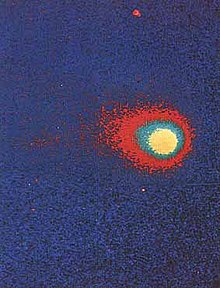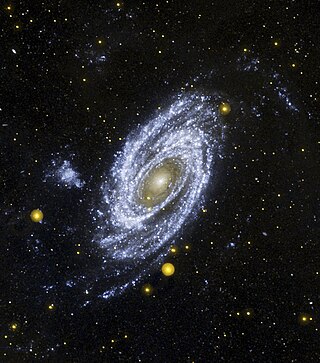
Ultraviolet astronomy is the observation of electromagnetic radiation at ultraviolet wavelengths between approximately 10 and 320 nanometres; shorter wavelengths—higher energy photons—are studied by X-ray astronomy and gamma-ray astronomy. Ultraviolet light is not visible to the human eye. Most of the light at these wavelengths is absorbed by the Earth's atmosphere, so observations at these wavelengths must be performed from the upper atmosphere or from space.

STS-85 was a Space Shuttle Discovery mission to perform multiple space science packages. It was launched from Kennedy Space Center, Florida, on 7 August 1997. A major experiment was the CRISTA-SPAS free-flyer which had various telescopes on board.
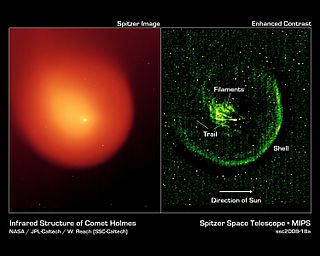
The coma is the nebulous envelope around the nucleus of a comet, formed when the comet passes near the Sun in its highly elliptical orbit. As the comet warms, parts of it sublimate; this gives a comet a diffuse appearance when viewed through telescopes and distinguishes it from stars. The word coma comes from the Greek κόμη (kómē), which means "hair" and is the origin of the word comet itself.

Skylab 4 was the third crewed Skylab mission and placed the third and final crew aboard the first American space station.

International Ultraviolet Explorer, was the first space observatory primarily designed to take ultraviolet (UV) electromagnetic spectrum. The satellite was a collaborative project between NASA, the United Kingdom's Science and Engineering Research Council and the European Space Agency (ESA), formerly European Space Research Organisation (ESRO). The mission was first proposed in early 1964, by a group of scientists in the United Kingdom, and was launched on 26 January 1978 aboard a NASA Thor-Delta 2914 launch vehicle. The mission lifetime was initially set for 3 years, but in the end it lasted 18 years, with the satellite being shut down in 1996. The switch-off occurred for financial reasons, while the telescope was still functioning at near original efficiency.

George Robert Carruthers was an African American inventor, physicist, engineer and space scientist. Carruthers perfected a compact and very powerful ultraviolet camera/spectrograph for NASA to use when it launched Apollo 16 in 1972. He designed it so astronauts could use it on the lunar surface, making all adjustments inside their bulky space suits. Upon instructions from Carruthers, they used the camera to record the Earth's outermost atmosphere, noting its variations, and also mapped portions of the far-ultraviolet sky recording stars and galaxies, and the gaseous media between them. In 1970, sending his instruments aboard Aerobee sounding rockets, he had demonstrated that molecular hydrogen exists in the interstellar medium. Among numerous citations and awards, in 2003, Carruthers was inducted into the National Inventors Hall of Fame, and he received an honorary doctorate for Engineering from Michigan Technological University. He also was awarded the 2011 National Medal for Technology and Invention from President Barack Obama, "For invention of the Far UV Electrographic Camera, which significantly improved our understanding of space and earth science."

The Astrogeology Science Center is the entity within the United States Geological Survey concerned with the study of planetary geology and planetary cartography. It is housed in the Shoemaker Building in Flagstaff, Arizona. The Center was established in 1963 by Eugene Merle Shoemaker to provide lunar geologic mapping and to assist in training astronauts destined for the Moon as part of the Apollo program.

The Apollo Telescope Mount, or ATM, was a crewed solar observatory that was a part of Skylab, the first American space station. It could observe the Sun in wavelengths ranging from soft X-rays, ultra-violet, and visible light.

The Cosmic Origins Spectrograph (COS) is a science instrument that was installed on the Hubble Space Telescope during Servicing Mission 4 (STS-125) in May 2009. It is designed for ultraviolet (90–320 nm) spectroscopy of faint point sources with a resolving power of ≈1,550–24,000. Science goals include the study of the origins of large scale structure in the universe, the formation and evolution of galaxies, and the origin of stellar and planetary systems and the cold interstellar medium. COS was developed and built by the Center for Astrophysics and Space Astronomy (CASA-ARL) at the University of Colorado at Boulder and the Ball Aerospace and Technologies Corporation in Boulder, Colorado.
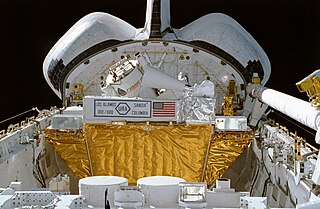
AFP-675 was a Space Shuttle experiment package that was carried into orbit on Discovery as part of STS-39.

Third-party evidence for Apollo Moon landings is evidence, or analysis of evidence, about the Moon landings that does not come from either NASA or the U.S. government, or the Apollo Moon landing hoax theorists. This evidence provides independent confirmation of NASA's account of the six Apollo program Moon missions flown between 1969 and 1972.

Interface Region Imaging Spectrograph (IRIS), also called Explorer 94 and SMEX-12, is a NASA solar observation satellite. The mission was funded through the Small Explorer program to investigate the physical conditions of the solar limb, particularly the interface region made up of the chromosphere and transition region. The spacecraft consists of a satellite bus and spectrometer built by the Lockheed Martin Solar and Astrophysics Laboratory (LMSAL), and a telescope provided by the Smithsonian Astrophysical Observatory (SAO). IRIS is operated by LMSAL and NASA's Ames Research Center.
The Venus Spectral Rocket Experiment (VeSpR) was a suborbital rocket telescope that collected data on the ultraviolet (UV) light that is being emitted from Venus's atmosphere, which can provide information about the history of water on Venus. Measurements of this type cannot be done using Earth-based telescopes because Earth's atmosphere absorbs most UV light before it reaches the ground.
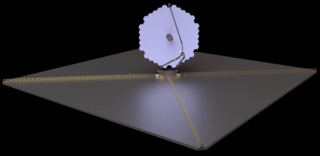
The Large Ultraviolet Optical Infrared Surveyor, commonly known as LUVOIR, is a multi-wavelength space telescope concept being developed by NASA under the leadership of a Science and Technology Definition Team. It is one of four large astrophysics space mission concepts studied in preparation for the National Academy of Sciences 2020 Astronomy and Astrophysics Decadal Survey.
Lunar Ultraviolet Cosmic Imager (LUCI) is a small planned telescope that will be landed on the Moon to scan the sky in near UV wavelengths. It is a technology demonstrator developed by the Indian Institute of Astrophysics, and it was planned to be one of several small payloads to be deployed by the commercial Z-01 lander developed by TeamIndus in partnership with OrbitBeyond. The mission was planned to be launched in 2020 as part of NASA's Commercial Lunar Payload Services (CLPS). On 29 July 2019 OrbitBeyond announced that it would drop out of the CLPS contract with NASA, meaning that the 2020 launch was canceled and it is unknown whether the mission will ever take place.

Alice is an ultraviolet imaging spectrometer, with one used on the New Horizons spacecraft, and another on the Rosetta spacecraft. Alice is a small telescope with a spectrograph and a special detector with 32 pixels each with 1024 spectral channels detecting ultraviolet light. The instrument has a mass of 4.4 kg and draws 4.4 watts of power. Its primary role is to determine the relative concentrations of various elements and isotopes in Pluto's atmosphere.
CubeSat UV Experiment (CUVE) is a space mission concept to study the atmospheric processes of the planet Venus with a small satellite. Specifically, the orbiter mission would study an enigmatic ultraviolet light absorber of unknown composition situated within the planet's uppermost cloud layer that absorbs about half the solar radiation downwelling in the planet's atmosphere.
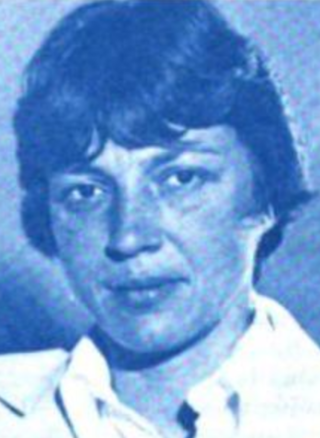
Dianne Kasnic Prinz was an American scientist, a physicist with the United States Naval Research Laboratory. She trained as an astronaut, and was mission communicator for STS-51-F.

Comet Kohoutek is a comet that passed close to the Sun towards the end of 1973. Early predictions of the comet's peak brightness suggested that it had the potential to become one of the brightest comets of the 20th century, capturing the attention of the wider public and the press and earning the comet the moniker of "Comet of the Century". Although Kohoutek became rather bright, the comet was ultimately far dimmer than the optimistic projections: its apparent magnitude peaked at only –3 and it was visible for only a short period, quickly dimming below naked-eye visibility by the end of January 1974.




